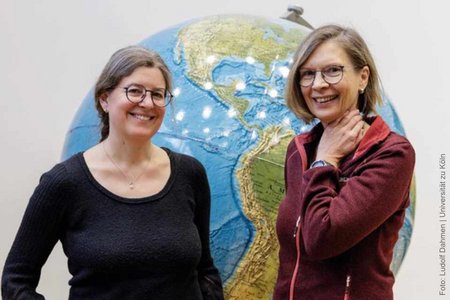Precise weather forecasts require an enormous amount of data. To create an accurate picture, these also have to be put together correctly. Researchers at the University of Cologne are contributing to improving the necessary algorithms – but not even this will allow us to escape every shower of rain.
Jan Voelkel
It all started with Lothar. The cyclone swept across Europe around Christmas 1999, sometimes at speeds of over two hundred kilometres per hour. In the end, the consequences were devastating. Lothar caused the worst storm damage in recent European history and claimed over a hundred lives. Nobody had predicted that the storm would have such severe effects. After the storm, the German Meteorological Service announced that a more effective warning system was required, but that the models used to forecast Lothar’s development had failed to capture the situation correctly. The need for improvements became obvious. “This was a major turning point for data assimilation in forecasting models,” said Professor Dr Nikki Vercauteren of the University of Cologne’s Institute of Geophysics and Meteorology.
Data assimilation – Professor Vercauteren’s speciality – is something like the IT branch of meteorology. The aim is to develop and implement intelligent observation methods to improve weather and climate models. More and better data are valuable, but what is needed above all are models that interpret this data or evaluate it according to its significance. “We want to put the missing puzzle pieces of Earth System Observation together and conduct research on how to combine observation results and models in the best way possible,” said the meteorologist.
Better forecasts with the help of machine learning
In general, the weather is a chaotic system with many random processes. Especially storms develop and change quickly. A slight change in the original weather situation can have a major impact and result in a completely different course. This is why – as Lothar demonstrated – spontaneous changes in the atmosphere must be taken into account more accurately. therefore collaborate closely with experts in theoretical computer science in order to find patterns in the data. “This also has a lot to do with machine learning. The computer scientists are evaluating which algorithm works best and demonstrably achieves correct results,” explained Vercauteren. “This allows uncertainties to be quantified and results in higher reliability of the forecasting models.”
This is the main focus of the UoC researchers, in collaboration with other universities such as the University of Bonn and in the framework of research partnerships such as CESOC.
CESOC – In the fall of 2020, the Universities of Cologne and Bonn as well as Forschungszentrum Jülich founded the Center for Earth System Observation and Computational Analysis (CESOC), whose aim is to observe and to understand comprehensively the Earth system, and to predict changes in it.
Many research projects are making use of artificial intelligence or machine learning. “However, we want to improve the underlying principles, for example machine learning and algorithms,” said Professor Dr Susanne Crewell from the University of Cologne. An example from the collaboration with computer scientists at the University of Bonn shows the great potential of this approach. “They have already improved certain processes by a factor of 100,000 in terms of computing time, simply by using clever algorithms.”
A second Earth
The aim for the future is to better represent and record the Earth system as a whole. This is where a digital twin of the planet comes in. It allows the researchers to observe and simulate processes not only in a single zone, such as the atmosphere or the ocean, but in the entire global interaction. The project ‘Destination Earth’ of the European Centre for Medium-Range Weather Forecasts (ECMWF) in Bonn, with which the CESOC meteorologists are collaborating, is working on the development of such a twin. “It’s a huge project,” said Crewell. The digital twin will be very innovative in terms of level of detail, quick access to information and interactivity. Once again, data assimilation makes a significant contribution to increasing the accuracy of patterns and scales and evaluating them more intelligently.”
Nikki Vercauteren is certain that, despite the progress made, future weather forecasts will still not be able to exceed a certain limit. From day ten onwards, for example, it has the accuracy of a coin toss, i.e. around fifty to sixty percent. But history also tells us that the precision and accuracy of forecasts has already improved significantly in recent years and decades. “The forecasts are now so good, especially up to day three, that they are eighty or ninety percent accurate. That was unimaginable fifty years ago,” said Vercauteren. It is very likely that research into smart forecasting models will lead to further progress and help to prevent disasters caused by extreme weather events such as Cyclone Lothar.
